
Jim Nowell and I arose at 5:00 AM and drove to Freighthouse Square in Tacoma and parked. Across the street at Freighthouse Square, we bought one-way Sounder tickets to Seattle, then boarded the cab car on this train. At 5:45 AM, it departed and through the train came Bob and Chris.

Sounder F59PHI 911 leading the Train 1504.

Jim enjoying his ride.

The interior of a Sounder coach, made by Bombardier. The two of them stood looking out of the front door of the cab car while Jim and I sat at a table. We were amazed how Sounder passengers form a queue and there is no pushing. The train took us to Seattle, where we arrived on time. Here, Sounder commuter trains do not have direct access to King Street Station, so we had to walk around the south side of the building to reach the station and I was surprised at how little progress had been made on the building's restoration.
Amtrak Cascades 501Before boarding, we checked in, where the conductor of Train 501 took our tickets and assigned us to Car 8.

Our train awaiting its passengers. Once we boarded, we found our seats.


The Bistro Car.

The coach section of the Cascades. Chris really liked riding the Talgo and enjoyed the tilting feature. It was a quick trip back to Tacoma and we walked over to the parking structure and drove to the Best Western for breakfast, after which Jim and I returned the key while Bob and Chris packed. Once all back in the car, we drove to Point Defiance Park then found Camp 6, our next train ride of the trip.
Camp 6 Logging MuseumThis museum was located on a 14-acre forested site inside Point Defiance Park in Tacoma. It was established in 1964 as the Camp Six Logging Exhibit by Western Forest Industries Museum, Inc. by members of the logging industry in Washington State. Camp 6 included a replica of an operating railroad connecting the working sites with the bunk houses and bunk cars of the camp. The museum was a National Registered Historic Place, and featured several historic buildings and over 500 tons of railroad and logging equipment. Many pieces of equipment were powered by steam. The museum was last operated by the Tacoma Chapter of the National Railway Historical Society from 1989 to 2010, staffed by volunteers, and funded by individual and corporate donations.
They have a small railroad with a loop of track that operates on the weekends. I had always wanted to visit and ride this unique Point Defiance, Quinault and Klickitat Railroad logging train ride. Knowing for once that I had a car, I e-mailed Camp 6 about two months beforehand and received a reply the day I was leaving from Rick Bacon, General Manager. At Banks, I called Cliff Chapman, who scheduled a special train for me to ride on Friday at 10:00 AM. I told several people about this trip on the POTB run on Tuesday and told them to meet me at Camp 6 Friday at 10:00 AM.
When we arrived, I found Elizabeth Davidge, Philip Kondziela, John Pennington and Rick Bleak waiting then met our crew who pointed me in the correct direction to buy tickets. We all then boarded the train, which had a Whitcomb locomotive, a log car and a Northern Pacific steel flat car converted into a covered open car.

Point Defiance, Quanault and Klickitat Railroad Whitcomb 40133, ex. Boise-Cascade, exx. West Tacoma Newsprint, nee Louisian Ship Yards 1 built by Whitcomb Locomotive Works in 1941.


In the engine house was Western Washington Forest Industries Museum 3 truck Shay 7 1964, ex. Klickitat Log and Lumber Company 7, exx. St. Regis Paper Company 7, exxx. J. Neils Lumber Company 7 1942, nee Somers Lumber Company (subsidiary of the Great Northern Railroad) 2 built by Lima Locomotive Works in 1929. It was notably completed on November 29, 1929, better known as "Black Friday", the beginning of the Great Depression.
Somers Lumber's mill was located on the shores of Flathead Lake, Montana and the town of Somers was constructed to provide housing and support services for the employees. It was then sold to Julius Neils and his son Paul, who operated sawmill and logging operations in Sauk Rapids, Minnesota and Libby, Montana, but also in 1922 had acquired the Western Pine Lumber Company at Klickitat, Washington. The Shay went to work at Neil's Klickitat Log and Lumber Company, which operated a logging railroad that once extended nearly 75 miles into the woods. The sawmill was served by a branch line of the Spokane, Portland and Seattle Railroad, which ran along the north bank of the Columbia River in Washington State.
With the arrival of log trucks in the late 1930's, the K.L.&L. Co. railroad was cut back to the 18 mile stretch that ran from the sawmill at Klickitat up through the Klickitat Canyon to the railroad reload located on the plateau above. From 1939 to 1964, J. Neils used Shay locomotives 5 and 7 to move the logs from the reload down to the sawmil. Shay 7 made its last run for the St. Regis Paper Company at Klickitat on May 2, 1964. The St. Regis Paper Company had merged with the J. Neils Lumber Company in 1957.
This shay was the last operating steam logging locomotive in the United States and was moved on the Northern Pacific Railroad to their South Tacoma workshops, where she was partially dismantled for the short truck haul to Camp 6. The Shay was soon in service at Camp 6, operating on a short piece of track by August 1964. The locomotive's engineer from Klickitat, Norman Elsner, was overjoyed that the engine was preserved, and regularly made the trip from Klickitat to Camp 6 to help operate the locomotive.
The engine operated until 1989 when it was retired from service pending boiler repairs and retubing.

Group photo of Philip Kondziela, John Pennington, Rick Bleak, Chris Parker, Bob Riskie, Jim Nowell and Elizabeth Davidge; our special train riders this morning.

A steam donkey.

We departed and passed five Polson Logging Company camp cabins from Rayonier's Quinault Camp 14. These were "car camp" cabins that were permanently placed on obsolete wooden flat cars in 1910, which had been purchased from the Northern Pacific Railroad, thus preserving a rare bit of Northern Pacific history.

Camp cabins on the left and privately-owned (by Ken Johnson), 0-4-0T 4, ex. A.J. French 1961, nee American Smelting & Refining Company 4 built by Davenport Locomotive Works in 1937.

The loop begins with this switch.
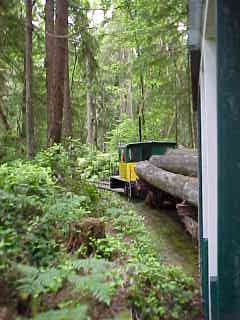

We were now running through the woods.
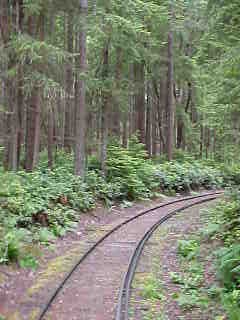
The view looking back.

A second steam donkey.

Curving through the forest.

Crossing a low wooden trestle..

Northern Pacific log car with a load


The Lidgerwood Tower Skidder from the Weyerhaeuser Company in 1966, a donation that would establish the identity of Camp 6 in the logging industry fraternity. Lidgerwood Manufacturing Company introduced the steel spar or "tower" skidder in 1911 to address the problem faced in logging operations of not having an adequate tree in the right location for a high pole, and the cost of constantly rigging a high pole and then moving to a new setting to rig the next. By the late 1920's, Weyerhaeuser was planning the development of their holdings to the east of Kelso, Washington.
The tower skidder had grown in size and complexity to become the ultimate in steam logging technology. Weyerhaeuser decided to equip the new Longview operation with the most modern machinery available, from the woods the to sawmill. In February 1929, one tree-rigged skidder and one tower skidder were ordered from the Lidgerwood Pacific Company of Tacoma, Washington. At the same time, two tree-rigged units were ordered from Washington Iron Works in Seattle. The Lidgerwood Tower Skidder would become Weyerhaeuser 3. In the late 1920's, both Lidgerwood Pacific, with its Atlas Imperial diesel engines and Washington Iron Works, with its Estep diesel engines, were entering the diesel era, and Weyerhaeuser Company was clearly bucking the technological trend with their steam skidder purchases.
Lidgerwood Manufacturing Company, headquartered in New York City, began manufacturing a variety of products, including hoisting engines, in 1873. The Lidgerwood patent monopoly on the interlocking skidder was about to lapse in 1921, and they began to look for a west coast manufacturer of their logging equipment that would make them competitive with the big west coast builders of logging equipment, Willamette Iron and Steel of Portland, Oregon, and Washington Iron Works of Seattle, Washington. In May 1922, a deal was struck between Lidgerwood and Puget Sound Iron and Steel of Tacoma, which gave PSIS the rights to manufacture Lidgerwood logging machinery on the west coast for 50 years, while Lidgerwood retained the sole responsibility for sales and distribution of the products of both companies in the west and for export overseas.
In 1927, Puget Sound Iron and Steel Works sold its interests to Lidgerwood Pacific Company. Pacific Iron and Steel took over Lidgerwood Pacific Company in 1931 and the last steam skidder was produced in 1937. In May 1929, the Weyco Tower Skidder 3 went to work near Headquarters Camp with Ike Bagnall as leverman. A short time later, an open house was held for all the top brass and their invited guests to show off the new logging operation. The biggest logs available had been lined up on the landing and along the skid road in preparation for the big show. Everyone was enjoying the show until two six-foot fir butt logs were hooked to the chokers and yarded to the landing. At the same time, the loader hoisted a third huge log for placement on a rail car. Bang! The main frame on the skidder broke in half. The riveted patches applied to the repaired skidder in 1929 are still clearly visible today. The little incident with skidder 3 did not sour Weyerhaeuser on tower skidders. Over the next several years, four more (5, 6, 7 and 8) were on the Longview operation.
By 1953 things were changing in the Weyerhaeuser Woods. Trucks were replacing railroads and diesel power was replacing steam power. Weyerhaeuser decided to keep its mainline railroad to Headquarters Camp, but the skidders were slated for retirement. February 12th, 1953, was chosen as the last day for Skidder 3; her four sisters were already cold. Ike Bagnall was the leverman on the last day, just as he had been on the first day, twenty-four years before. A large crowd of old timers gathered near Camp 10 to say goodbye to steam logging and the days of their youth. Upon her retirement, Skidder 3 still held the Longview record of 73 cars of logs skidded and loaded in one day.
This story would have ended here with a short flurry of activity by a scrapper if it had not been for Mr. J. P. Weyerhaeuser, Jr. On October 23, 1953, H. E. Morgan, manager of the Longview Lumber Division, wrote to Mr. Weyerhaeuser asking about the possibility of a historic display of a skidder and locomotive near the guest house. Mr. Weyerhaeuser was taken with the idea and instructed General Manager Charles Ingram to go ahead with the project. Skidder 3 was brought down to Headquarters Camp and stripped down for a cleaning and coat of paint. After a last trip down the hill, she was reassembled at the mill and made ready for display. On June 2, 1954, Ike Bagnall once again raised the 3's 110-foot tower to the sky for the last time.

The view back.
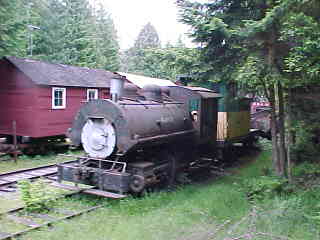
American Smelting & Refining Company 0-4-0T 4.
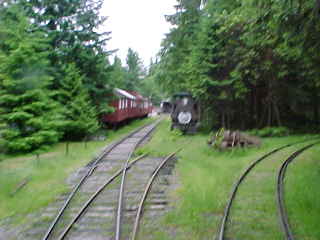
After we completed the loop, we went around a second time.

After our second trip, we reversed into the station area.

The camp cars. After we finished our ride, we gave our train crew a hearty thank you for such a special trip.

Our train at rest.

We wandered the grounds of the museum and found Rayioner caboose 3 built by the railroad, year unknown.

The wye track which is used to turn equipment to even out the wheel wear.

Behind the engine shop was Gibson speeder trailer, Construction Number 276 and Point Defiance Quinault & Klickitat Railroad DLC 6 8 ton switcher 2689, ex. West Tacoma Newsprint, exx. Everett Pulp and Paper, nee Johnson, Drake and Piper built by Plymouth in 1927.





Various steam donkeys on the grounds.

Later, back at the train our Whitcomb switcher that had pulled our special train.

A different view of the camp cars.

Box car and the fire train, After exploring, seeing equipment pictures and the history of logging inside the camp cars, it was time to move on. A special thank you to the Camp 6 Logging Museum for having us today and running a special train for our group.
Details on the equipment at Camp 6 taken from Volume 29, No. 3 (December 2011) of the Roots Newsletter published by the Roots of Motive Power in Willits, California.
South to Portland 6/9/2006Elizabeth wanted to join us on our way to Battle Ground, Washington so I rode with her to there and we led the way with Jim driving Bob and Chris. While the other stopped at Subway, we took the Vader exit and went down to the track in the hopes of seeing some trains.
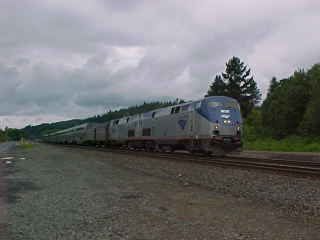
We caught the late-running Coast Starlight Train 11 speeding south.

A southbound BNSF freight train with SD40-2 6731, SD40-2 7898 and SD40 6308 came through ten minutes later. The others then joined us and we gleefully reported on what they missed. We left Vader and made our way to Battle Ground.



Spokane, Portland and Seattle 2-8-2 539, nee Northern Pacific 1762, built by American Locomotive Company in 1917. It was retired in 1957 and displayed at Esther Short Park in Vancouver, Washington until 1997 when moved to Battle Ground for a potential restoration that never occurred.

The sign about the steam engine.
We then said goodbye to Elizabeth, who was returning to Lynnwood then her home in Victoria, British Columbia, while we continued on to Portland and the Days Inn at 82nd Street and Interstate 84. Almost as soon as we entered Interstate 205, the low fuel light came on and we made it to a Shells station at Sandy Boulevard where we put in $20 of petrol. Our rental car had a prepaid tank, so we needed to return the car as near empty as possible on Sunday. We then checked into the Days Inn for two nights. After some rest time in our rooms, we walked over to Elmer's for dinner and I had Prime Rib.
Bob, Chris and I then took the MAX Light Rail to Lloyd Center where I checked Trainorders.com for any information on the Southern Pacific 4449 excursion to Sherwood tomorrow but there was nothing. That was followed by a walk to Radio Shack for more floppy disks then I took Bob and Chris to Chinatown and they had their first ride on the MAX Expo Line. We returned to the Days Inn where I watched the College World Series and saw Cal State Fullerton make a big comeback against Missouri in Game One of their best-of-three, before calling it a night.
| RETURN TO THE MAIN PAGE |